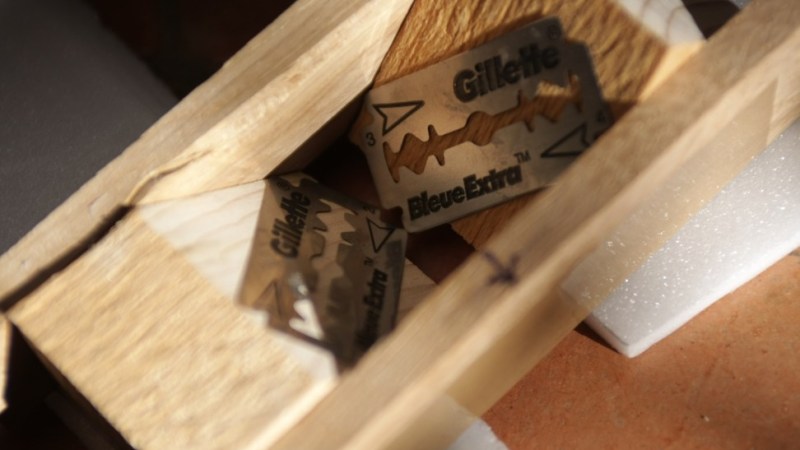If the only tool you have is a hammer, everything looks like a nail. Conversely, if you have the right tool for every job, it makes the difference between pro and amateur. [ftregan] needs to cut perfect V-grooves in foam for many of his projects, especially building RC planes. He wasn’t too satisfied with the results using his Xacto knife. And a proper tool was going to set him back by almost $25, but following that example he built his own version of the tool for much less.
Two pieces of wood cut at a 45 degree angle are held between two flat support pieces. A pair of regular shaving blades form the cutting elements. While it looks simple, it’s important to get the angles and blade directions correct. A central wooden wedge holds the two blades in place. He also added a small guide marker that let’s you cut precise straight grooves. [ftregan] built the tool to allow cutting 6mm thick foam but given that it’s so quick and cheap to build, we guess it’s easy to make a few of these to allow cutting different thicknesses of foam. We’re sure that many of you will find different or better ways of doing this, but considering [ftregan] spent just 15 minutes cooking this up, it’s not too bad, especially since the results are mighty good.
Another method of cutting foam is with hot wire. Check out this DIY Foam Cutter that we featured earlier.















Pretty ingenious. I like the simplicity and effectiveness. Could be useful to when building custom foam-lined cases for equipment protection.
I hadn’t thought of flipping the one block to get the perfect 90. I would have foolishly tried cutting “perfect” 45s and then become frustrated. Great tip!
So how are the blades held in? Are they just jammed in against the side pieces?
Looks like it. The force of using the tool will just jam the blades in tighter as well. Very nice.
They are taped in place with scotch tape.
I like seeing stuff like this. Very clever indeed.
Why pay for a commercially produced tool when you can make one yourself?
Safety? Ergonomics? Ease of use? Don’t have to build it yourself?
We’re talking about a foam cutter, not a radial arm saw. As for safety, I think anyone who has skill in woodworking can probably be trusted to handle razor blades properly. Ergonomics and ease of use can be incorporated into DIY tools, and building something yourself provides a level of satisfaction that just isn’t present with store-bought tools.
Just because one has experience handling woodworking tools doesn’t mean one should consider a device that has no safety and razor sharp blades that stick out all of the time to be safe. Plus, what happens when somebody without said experience starts to use said device? Or the experienced user has a momentary lapse of attention? Fortunately, this device is self limiting in the damage it can cause but it could still cut you pretty badly. Ergonomics can be incorporated, sure, but not while also being cheap and dirty and quick. I also agree that there is a level of satisfaction with building your own tools but I disagree that this device rises to the level of a quality commercially engineered replacement in it’s current form.
Yes, exacto knives are amazingly horrible and dangerous things….
Commercial cutters exist but they kinda suck *and* use special blades which are rather expensive.
Did something like this years ago to cut strips of foam for compression gaskets – well done!
I use a tool just like this that I made to cut 1″ foam board for hvac duct systems. Exactly the same design, whipped it up in about 15 minutes. That was about 3 years ago. Just swap out the blades every now and then.
Great shoot from the hip project . People have to realize there is some measure of danger in working with tools diy or commercially made common sense should prevail. Too much of what we do is limited by the fear of legal ramifications or by the fear instilled by the people who relie on said legal ramifications .